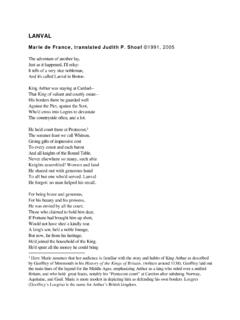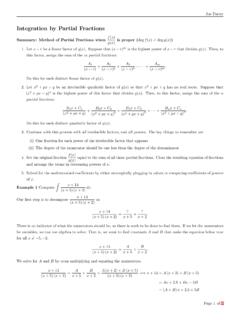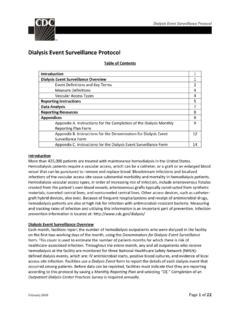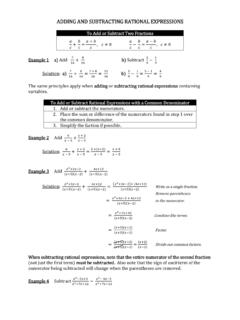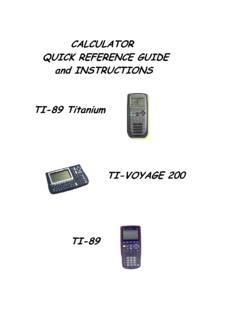Transcription of Section 7.4: Inverse Laplace Transform - People
1 Section : Inverse Laplace TransformA natural question to ask about any function is whether it has an Inverse now ask this question about the Laplace Transform : given a functionF(s), will therebe a functionf(t) such thatF(s) =L{f}(s)? It turns out that there is at most onecontinuous functionf(t) which satisfies this property (there could be infinitely manydiscontinuous functions with the same Laplace Transform , but we prefer to work withcontinuous functions). a functionF(s), if there is a functionf(t) that is continuous on [0, )and satisfiesL{f}=F, then we say thatf(t) is the Inverse Laplace transformofF(s)and employ the notationf=L 1{F}.This idea has more than theoretical interest, however; we ll see in the next Section thatfinding Inverse Laplace transforms is a critical step in solving initial value problems.]
2 Todetermine the Inverse Laplace Transform of a function, we try to match it with the formof an entry in the right-hand column of a Laplace 1{F}for(a)F(s) =2s3,(b)F(s) =3s2+ 9,(c)F(s) =s 1s2 2s+ (a)L 1{2s3}(t) =L 1{2!s3}(t) =t2(b)L 1{3s2+ 9}(t) =L 1{3s2+ 32}(t) = sin(3t)(c)L 1{s 1s2 2s+ 5}(t) =L 1{s 1(s 1)2+ 22}(t) =etcos(2t). Of course, very often the Transform we are given will not correspond exactly to an entryin the Laplace table. One tool we can use in handling more complicated functions is thelinearity of the Inverse Laplace Transform , a property it inherits from the original thatL 1{F},L 1{F1}, andL 1{F2}exist and are continuouson[0, )and letcbe any constant. ThenL 1{F1+F2}=L 1{F1}+L 1{F2},L 1{cF}=cL 1{F}.Example 1{5s 6 6ss2+ 9+32s2+ 8s+ 10}. linearity, we haveL 1{5s 6 6ss2+ 9+32s2+ 8s+ 10}= 5L 1{1s 6} 6L 1{ss2+ 9}+32L 1{1s2+ 4s+ 5}.]
3 12 Rewriting the final term using completing the square, it becomesL 1{1(s+ 2)2+ 12}.Therefore, by the Laplace table we see thatL 1{5s 6 6ss2+ 9+32s2+ 8s+ 10}(t) = 5e6t 6 cos(3t) +32e 2tsint. Example 1{5(s+ 2)4}. fourth power in the denominator suggests that the Inverse Laplace trans-form is of the formL 1{n!(s a)n+1}(t) = this case,a= 2,n= 3, so by linearity we haveL 1{5(s+ 2)4}(t) =56L 1{3!(s+ 2)4}(t) =56e 2tt3. Example 1{3s+ 2s2+ 2s+ 10}. completing the square, the denominator can be rewritten ass2+ 2s+ 10 =s2+ 2s+ 1 + 9 = (s+ 1)2+ , the form ofF(s) suggests the following two formulas from the Laplace table:L 1{s a(s a)2+b2}(t) =eatcos(bt),L 1{b(s a)2+b2}(t) =eatsin(bt),where we havea= 1,b= 3. Thus, we want to write3s+ 2s2+ 2s+ 10=As+ 1(s+ 1)2+ 32+B3(s+ 1)2+ 32for an appropriate choice of constantsA,B. By clearing the denominator, we have theequation3s+ 2 =A(s+ 1) + 3B=As+ (A+ 3B).
4 Equating coefficients gives usA= 3,B= 1/3, so by linearity, we haveL 1{3s+ 2s2+ 2s+ 10}(t) = 3L 1{s+ 1(s+ 1)2+ 32}(t) 13L 1{3(s+ 1)2+ 32}(t)= 3e tcos(3t) 13e tsin(3t). 3In Example 4, we found it easier to take the Laplace Transform of the broken up fractionthan of the original combined fraction. The procedure we used above, which you mayrecall from Calculus 2 and which will prove very useful in simplifying these functions, iscalled themethod of partial fractions. Because of its importance, we now review of Partial FractionsA rational functionP(s)/Q(s), whereP(s),Q(s) are polynomials with the degree ofPless than the degree ofQ, has a partial fraction expansion based on the factorization ofQ. There are three main cases to consider, the easiest being that of nonrepeated linearfactors. IfQ(s) is a product of distinct linear factors,Q(s) = (s r1)(s r2) (s rn),then the partial fraction expansion has the formP(s)Q(s)=A1s r1+A2s r2+ +Ans constantsA1.
5 ,Ancan be derived by clearing denominators and either equatingcoefficients of the resulting polynomials as in Example 4, or by careful substitution. Wedemonstrate the second way in the following 1{F}forF(s) =7s 1(s+ 1)(s+ 2)(s 3). the denominator has three distinct linear factors, the partial fractionexpansion has the form7s 1(s+ 1)(s+ 2)(s 3)=As+ 1+Bs+ 2+Cs 3,and upon clearing denominators (multiplying through by (s+ 1)(s+ 2)(s 3)), we have(1)7s 1 =A(s+ 2)(s 3) +B(s+ 1)(s 3) +C(s+ 1)(s+ 2).If we substitutes-values which make the linear factors zero, then each time two termswill drop out and it will be simple to solve for each coefficient. First lets= 1; then (1)becomes 8 = 4A A= , lettings= 2 gives 15 = 5B B= 3,and lettings= 3 yields20 = 20C C= , we can now use linearity to calculate the Inverse Laplace Transform :L 1{7s 1(s+ 1)(s+ 2)(s 3)}(t) =L 1{2s+ 1 3s+ 2+1s 3}(t)= 2L 1{1s+ 1}(t) 3L 1{1s+ 2}(t) +L 1{1s 3}(t)= 2e t 3e 2t+e3t.
6 The second scenario involves repeated linear factors. If the highest power ofs rthatdividesQ(s) is (s r)m, then the portion of the partial fraction expansion correspondingto (s r)misA1s r+A2(s r)2+ +Am(s r) 1{s2+ 9s+ 2(s 1)2(s+ 3)}. partial fraction expansion has the forms2+ 9s+ 2(s 1)2(s+ 3)=As 1+B(s 1)2+Cs+ denominators gives(2)s2+ 9s+ 2 =A(s 1)(s+ 3) +B(s+ 3) +C(s 1) , we substitute values which make the linear factors vanish. Lettings= 1 in (2)gives12 = 4B B= 3,and lettings= 3 yields 16 = 16C C= find the third constant, we can plug in any other value fors; a convenient choice iss= 0:2 = 3A+ 3B+C= 3A+ 9 1 6 = 3A A= , the Inverse Laplace Transform isL 1{s2+ 9s+ 2(s 1)2(s+ 3)}(t) =L 1{2s 1+3(s 1)2 1s+ 3}(t)= 2L 1{1s 1}(t) + 3L 1{1(s 1)2}(t) L 1{1s+ 3}(t)= 2et+ 3tet e 3t. The most difficult case is that of a quadratic factor.
7 Ifmis the highest power of(s )2+ 2that dividesQ(s), then the partial fraction expansion for that term isA1s+B1(s )2+ 2+A2s+B2[(s )2+ 2]2+ +Ams+Bm[(s )2+ 2] , for looking up Laplace transforms it is more convenient to have numeratorsof the formAi(s ) + Bi, so we can equivalently writeA1(s ) + B1(s )2+ 2+A2(s ) + B2[(s )2+ 2]+ +Am(s ) + Bm[(s )2+ 2] 1{2s2+ 10s(s2 2s+ 5)(s+ 1)}. the quadratic factor in the denominator is irreducible, we rewrite usingcompleting the square:s2 2s+ 5 = (s 1)2+ 22. Then the partial fraction expansionhas the form2s2+ 10s(s2 2s+ 5)(s+ 1)=A(s 1) + 2B(s 1)2+ 22+Cs+ denominators gives(3)2s2+ 10s= [A(s 1) + 2B](s+ 1) +C(s2 2s+ 5).There are two linear terms involved in this expression, so pick the twos-values whichmake them vanish. Whens= 1, we get 8 = 8C C= 1, we get12 = 4B+ 4C= 4B 4 4B= 16 B= the final constant, sets= 0:0 = A+ 2B+ 5C A= 2(4) + 5( 1) = , we find the Inverse Laplace Transform to beL 1{2s2+ 10s(s2 2s+ 5)(s+ 1)}=L 1{3(s 1) + 2(4)(s 1)2+ 22 1s+ 1}= 3L 1{s 1(s 1)2+ 22}+ 4L 1{2(s 1)2+ 22} L 1{1s+ 1}= 3etcos(2t) + 4etsin(2t) e t.
8 Homework: pp. 374-375, #1-29 odd.


